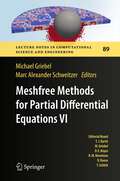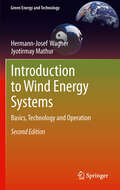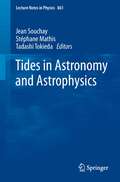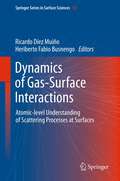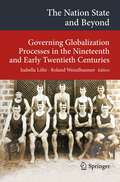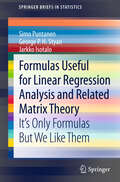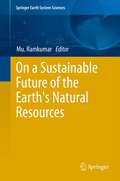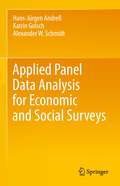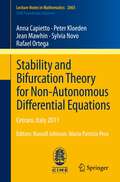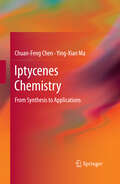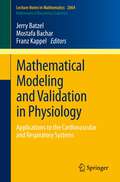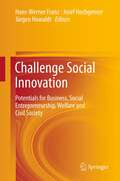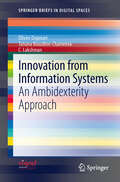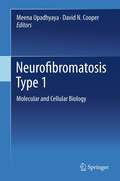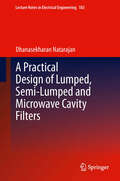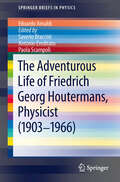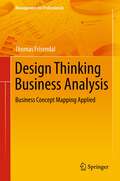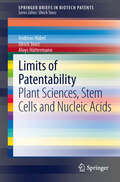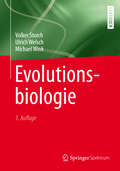- Table View
- List View
Meshfree Methods for Partial Differential Equations VII
by Michael Griebel Marc Alexander SchweitzerMeshfree methods, particle methods, and generalized finite element methods have witnessed substantial development since the mid 1990s. The growing interest in these methods is due in part to the fact that they are extremely flexible numerical tools and can be interpreted in a number of ways. For instance, meshfree methods can be viewed as a natural extension of classical finite element and finite difference methods to scattered node configurations with no fixed connectivity. Furthermore, meshfree methods offer a number of advantageous features which are especially attractive when dealing with multiscale phenomena: a priori knowledge about particular local behavior of the solution can easily be introduced in the meshfree approximation space, and coarse-scale approximations can be seamlessly refined with fine-scale information. This volume collects selected papers presented at the Seventh International Workshop on Meshfree Methods, held in Bonn, Germany in September 2013. They address various aspects of this highly dynamic research field and cover topics from applied mathematics, physics and engineering.
Introduction to Wind Energy Systems: Basics, Technology and Operation, 2nd Edition
by Hermann-Josef Wagner Jyotirmay MathurThe present book was written to address the needs of those readers interested in wind energy converters. The authors have tried to strike a balance between a short book chapter and a very detailed book for experts in the field. There were three prime reasons behind doing so: first, the field is highly interdisciplinary and requires a more accessible format for non-experts. The second reason for this more compact version is that both authors have encountered many students and technically oriented people who were searching for this type of book on wind energy. The third reason and motivation for writing this book was to provide some initial information to people who are embarking on a career in the wind industry. It is this group of people that the present book is targeted at.
Epitaxy of Semiconductors
by Udo W. PohlIntroduction to Epitaxy provides the essential information for a comprehensive upper-level graduate course treating the crystalline growth of semiconductor heterostructures. Heteroepitaxy represents the basis of advanced electronic and optoelectronic devices today and is considered one of the top fields in materials research. The book covers the structural and electronic properties of strained epitaxial layers, the thermodynamics and kinetics of layer growth, and the description of the major growth techniques metalorganic vapor phase epitaxy, molecular beam epitaxy and liquid phase epitaxy. Cubic semiconductors, strain relaxation by misfit dislocations, strain and confinement effects on electronic states, surface structures and processes during nucleation and growth are treated in detail. The Introduction to Epitaxy requires only little knowledge on solid-state physics. Students of natural sciences, materials science and electrical engineering as well as their lecturers benefit from elementary introductions to theory and practice of epitaxial growth, supported by pertinent references and over 200 detailed illustrations.
Tides in Astronomy and Astrophysics
by Jean Souchay Stéphane Mathis Tadashi TokiedaBased on the lecture notes of a school titled 'Tides in Astronomy and Astrophysics' that brought together students and researchers, this book focuses on the fundamental theories of tides at different scales of the universe--from tiny satellites to whole galaxies--and on the most recent developments. It also attempts to place the study of tides in a historical perspective. Starting with a general tutorial on tides, the theme of tides is approached in 9 chapters from many directions. They allow non-experts to pick up a physical intuition and a sense of orders of magnitude in the theory of tides. These carefully prepared lecture notes by leaders in the field include many illustrative figures and drawings. Some even offer a variety of simple back-of the-envelope problems.
Understanding Viscoelasticity: An Introduction to Rheology
by Nhan Phan-ThienThis book presents an introduction to viscoelasticity; in particular, to the theories of dilute polymer solutions and dilute suspensions of rigid particles in viscous and incompressible fluids. These theories are important, not just because they apply to practical problems of industrial interest, but because they form a solid theoretical base upon which mathematical techniques can be built, from which more complex theories can be constructed, to better mimic material behaviour. The emphasis is not on the voluminous current topical research, but on the necessary tools to understand viscoelasticity at a first year graduate level. The main aim is to provide a still compact book, sufficient at the level of first year graduate course for those who wish to understand viscoelasticity and to embark in modeling of viscoelastic multiphase fluids. To this end, a new chapter on Dissipative Particle Dynamics (DPD) was introduced which is relevant to model complex-structured fluids. All the basic ideas in DPD are reviewed, with some sample problems to illustrate the methodology.
Dynamics of Gas-Surface Interactions
by Ricardo Diez Muino Heriberto Fabio BusnengoThis book gives a representative survey of the state of the art of research on gas-surface interactions. It provides an overview of the current understanding of gas surface dynamics and, in particular, of the reactive and non-reactive processes of atoms and small molecules at surfaces. Leading scientists in the field, both from the theoretical and the experimental sides, write in this book about their most recent advances. Surface science grew as an interdisciplinary research area over the last decades, mostly because of new experimental technologies (ultra-high vacuum, for instance), as well as because of a novel paradigm, the 'surface science' approach. The book describes the second transformation which is now taking place pushed by the availability of powerful quantum-mechanical theoretical methods implemented numerically. In the book, experiment and theory progress hand in hand with an unprecedented degree of accuracy and control. The book presents how modern surface science targets the atomic-level understanding of physical and chemical processes at surfaces, with particular emphasis on dynamical aspects. This book is a reference in the field.
The Nation State and Beyond
by Roland Wenzlhuemer Isabella LöhrThe history of globalization is anything but a no-frills affair that moves smoothly along a clear-cut, unidirectional path of development, eventually leading to seamless global integration. Accordingly, scholarship in the social sciences has increasingly argued against equating the history of globalization processes and transcultural entanglements with the master narrative of the gradual homogenization of the world. Examining the shifting patterns of global connections has, therefore, become the main challenge for all those who seek to understand the past, the present and the future of modern societies. And this challenge includes finding a place for the nation state. The studies presented here argue that looking at the nation state from the perspective of global entanglements opens the door for its interpretation as a dynamic and multi-layered structure that takes part in globalization processes and plays various and at times even contradictory roles at the same time.
Formulas Useful for Linear Regression Analysis and Related Matrix Theory: It's Only Formulas But We Like Them
by Simo Puntanen George P. Styan Jarkko IsotaloThis is an unusual book because it contains a great deal of formulas. Hence it is a blend of monograph, textbook, and handbook.It is intended for students and researchers who need quick access to useful formulas appearing in the linear regression model and related matrix theory. This is not a regular textbook - this is supporting material for courses given in linear statistical models. Such courses are extremely common at universities with quantitative statistical analysis programs.
Narrative Brand Planning
by Ralf Schmidt-Bleeker Frank Otto DietrichNarrative Brand Planning - wie Marken zu echten Helden werden Das digitale Zeitalter hat die gute alte Werbewelt gehörig auf den Kopf gestellt. Mediennutzer haben sich vom passiven Konsumenten hin zu aktiven Produzenten von Medieninhalten entwickelt - und das jederzeit und überall! Leider hat das konventionelle Marketing die Menschen schon seit langem aus den Augen verloren. Als Reaktion verhängen wir Menschen immer häufiger die Höchststrafe: vollkommenes Desinteresse an Marken und ihren Versprechen. Was die digitale Welt aus Menschen, Medien und Marken jedoch nach wie vor braucht wie die Luft zum Atmen, sind echte Geschichten! Werbung muss weg von fiktiven Erzählungen innerhalb einzelner Werbemaßnahmen, hin zu realen Handlungen auf Markenebene! Das erzeugt spannende, transmediale und vor allem glaubwürdige Geschichten, die sich Menschen gut und gerne erzählen. Frank Otto Dietrich und Ralf Schmidt-Bleeker entwerfen mit Narrative Brand Planning einen Ansatz, wie man im digitalen Zeitalter Relevanz für Geschäftsmodelle, für Markenstrategien und Markenkommunikation erzeugen kann. Oder kurz: wie man Marken Schritt für Schritt zu echten Helden macht.
On a Sustainable Future of the Earth's Natural Resources
by Mu. RamkumarOn a Sustainable Future of the Earth's Natural Resources is divided into three sections, with individual chapters contributed by experts on diff erent facets of the earth sciences, natural resources management and related issues. The first section focuses on the status of Earth's resources; land, water, biota and atmosphere. Reviews on the rate of exploitation and the need to conserve these resources for future sustenance are also covered in this section. Th e following section includes chapters elucidating environmental, ecological, climatological and anthropological pressures on sustained nourishment with the Earth's resources. The last section describes management practices, issues and perspectives on sociological, legal, administrative, ICT and strategic efforts that need to be implemented in order to sustain our natural resources. This book covers a broad spectrum of the Earth's resources and sustenance, offering a comprehensive perspective on their past, present and future.
Applied Panel Data Analysis for Economic and Social Surveys
by Katrin Golsch Hans-Jürgen Andreß Alexander W. SchmidtMany economic and social surveys are designed as panel studies, which provide important data for describing social changes and testing causal relations between social phenomena. This textbook shows how to manage, describe, and model these kinds of data. It presents models for continuous and categorical dependent variables, focusing either on the level of these variables at different points in time or on their change over time. It covers fixed and random effects models, models for change scores and event history models. All statistical methods are explained in an application-centered style using research examples from scholarly journals, which can be replicated by the reader through data provided on the accompanying website. As all models are compared to each other, it provides valuable assistance with choosing the right model in applied research. The textbook is directed at master and doctoral students as well as applied researchers in the social sciences, psychology, business administration and economics. Readers should be familiar with linear regression and have a good understanding of ordinary least squares estimation.
Stability and Bifurcation Theory for Non-Autonomous Differential Equations
by Miguel Ortega Russell Johnson Sylvia Novo Anna Capietto Jean Mawhin Maria Patrizia Pera Peter KloedenThis volume contains the notes from five lecture courses devoted to nonautonomous differential systems, in which appropriate topological and dynamical techniques were described and applied to a variety of problems. The courses took place during the C.I.M.E. Session "Stability and Bifurcation Problems for Non-Autonomous Differential Equations," held in Cetraro, Italy, June 19-25 2011. Anna Capietto and Jean Mawhin lectured on nonlinear boundary value problems; they applied the Maslov index and degree-theoretic methods in this context. Rafael Ortega discussed the theory of twist maps with nonperiodic phase and presented applications. Peter Kloeden and Sylvia Novo showed how dynamical methods can be used to study the stability/bifurcation properties of bounded solutions and of attracting sets for nonautonomous differential and functional-differential equations. The volume will be of interest to all researchers working in these and related fields.
Iptycenes Chemistry
by Chuan-Feng Chen Ying-Xian MaIptycenes Chemistry: From Synthesis to Applications provides a comprehensive overview of the development of iptycene chemistry in the past seventy years. This book covers: (1) the basic nomenclature and general properties of iptycenes and their derivatives; (2) the synthesis and functionalization reactions of triptycenes, pentiptycenes, higher iptycenes, heterotriptycenes, and homotriptycenes; (3) the methods for the preparation of iptycene-based polymers with different types; and (4) the applications of iptycenes and their derivatives in molecular machines, materials science, host-guest chemistry, self-assembly, coordination chemistry, physical organic chemistry, medicinal chemistry, and so on. Consequently, such a book is not only helpful to researchers working in iptycene chemistry, but can also facilitate future research in wide areas.
Mathematical Modeling and Validation in Physiology
by Mostafa Bachar Jerry J. Batzel Franz KappelThis volume synthesizes theoretical and practical aspects of both the mathematical and life science viewpoints needed for modeling of the cardiovascular-respiratory system specifically and physiological systems generally. Theoretical points include model design, model complexity and validation in the light of available data, as well as control theory approaches to feedback delay and Kalman filter applications to parameter identification. State of the art approaches using parameter sensitivity are discussed for enhancing model identifiability through joint analysis of model structure and data. Practical examples illustrate model development at various levels of complexity based on given physiological information. The sensitivity-based approaches for examining model identifiability are illustrated by means of specific modeling examples. The themes presented address the current problem of patient-specific model adaptation in the clinical setting, where data is typically limited.
Challenge Social Innovation: Potentials for Business, Social Entrepreneurship, Welfare and Civil Society
by Josef Hochgerner Jürgen Howaldt Hans-Werner FranzIn recent years, social innovation has experienced a steep career. Numerous national governments and large organisations like the OECD, the European Commission and UNESCO have adopted the term. Social innovation basically means that people adopt new social practices in order to meet social needs in a different or more effective way. Prominent examples of the past are the Red Cross and the social welfare state or, at present, the internet 2.0 transforming our communication and cooperation schemes, requiring new management concepts, even empowering social revolutions. The traditional concept of innovation as successful new technological products needs fundamental rethinking in a society marked by knowledge and services, leading to a new and enriched paradigm of innovation. There is multiple evidence that social innovation will become of growing importance not only concerning social integration, equal opportunities and dealing with the greenhouse effects but also with regard to preserving and expanding the innovative capacity of companies and societies. While political authorities stress the social facets of social innovation, this book also encompasses its societal and systemic dimensions, collecting the scientific expertise of renowned experts and scholars from all over the world. Based on the contributions of the first world-wide science convention on social innovation from September 2011 in Vienna, the book provides an overview of scientific approaches to this still relatively new field. Forewords by Agnès HUBERT (Member of the Bureau of European Policy Advisers (BEPA) of the European Commission) and Antonella Noya (Senior Policy Analyst at OECD, manager of the OECD LEED Forum on Social Innovations)
Innovation from Information Systems
by Tatiana Bouzdine-Chameeva C. Lakshman Olivier DupouetRelying on the extensive study of a multi-national Company, this work proposes a process view of the way firms balance tensions between exploring new knowledge and exploiting old one. First, ideas are generated throughout the organization. These ideas are funneled towards specific project teams that further develop and refine them. Second, projects are assessed by the top management. Agreed projects are then progressively transformed into exploitable products, following a transformative learning process. We then make propositions regarding the role information systems can play in sustaining this process. Regarding the first phase of the cycle, we will focus on systems that help in sustaining idea generation and in balancing explorative and exploitive projects in the technologies portfolio of the firm. Regarding the second phase, we will look at information systems that could be useful in supporting knowledge transfer and knowledge interpretation across a multi-national company.
Microbial Metal Respiration
by Andreas Kappler Johannes GescherMicrobes can respire on metals. This seemingly simple finding is one of the major discoveries that were made in the field of microbiology in the last few decades. The importance of this observation is evident. Metals are highly abundant on our planet. Iron is even the most abundant element on Earth and the forth most abundant element in the Earth's crust. Hence, in some environments iron, but also other metals or metalloids, are the dominant respiratory electron acceptors. Their reduction massively drives the carbon cycle in these environments and establishes redox cycles of the metallic electron acceptors themselves. These redox cycles are not only a driving force for other biotic reactions but are furthermore necessary for initiating a number of geochemically relevant abiotic redox conversions. Although widespread and ecologically influential, electron transfer onto metals like ferric iron or manganese is biochemically challenging. The challenge is to transfer respiratory electrons onto metals that occur in nature at neutral pH in the form of metal oxides or oxihydroxides that are effectively insoluble. Obviously, it is necessary that the microbes specially adapt in order to catalyze the electron transfer onto insoluble electron acceptors. The elucidation of these adaptations is an exciting ongoing process. To sum it up, dissimilatory metal reduction has wide-spread implications in the field of microbiology, biochemistry and geochemistry and its discovery was one of the major reasons to establish a novel scientific field called geomicrobiology. Recently, the discovery of potential applications of dissimilatory metal reducers in bioremediation or current production in a microbial fuel cell further increased the interest in studying microbial metal reduction
Neurofibromatosis Type 1
by Meena Upadhyaya David N CooperNeurofibromatosis type 1 (NF1), caused by mutational inactivation of the NF1 tumour suppressor gene, is one of the most common dominantly inherited human disorders, affecting 1 in 3000 individuals worldwide. This book presents in concise fashion, but as comprehensively as possible, our current state of knowledge on the molecular genetics, molecular biology and cellular biology of this tumour predisposition syndrome. Written by internationally recognized experts in the field, the 44 chapters that constitute this edited volume provide the reader with a broad overview of the clinical features of the disease, the structure and expression of the NF1 gene, its germ line and somatic mutational spectra and genotype-phenotype relationships, the structure and function of its protein product (neurofibromin), NF1 modifying loci, the molecular pathology of NF1-associated tumours, animal models of the disease, psycho-social aspects and future prospects for therapeutic treatment.
A Practical Design of Lumped, Semi-lumped & Microwave Cavity Filters (Lecture Notes in Electrical Engineering #183)
by Dhanasekharan NatarajanThis book presents the application of microwave literature for designing lumped/semi-lumped filters and combline/iris-coupled microwave cavity filters. It provides the physical understanding of the terms and characteristics of radio frequency (RF) filters. The book complements engineering text books on RF components and provides support for the project assignments of students. In addition to the functional design of RF filters, the integrated design approach for produceability and reliability is explained.
Topological Insulators: Dirac Equation in Condensed Matters
by Shun-Qing ShenTopological insulators are insulating in the bulk, but process metallic states present around its boundary owing to the topological origin of the band structure. The metallic edge or surface states are immune to weak disorder or impurities, and robust against the deformation of the system geometry. This book, the first of its kind on topological insulators, presents a unified description of topological insulators from one to three dimensions based on the modified Dirac equation. A series of solutions of the bound states near the boundary are derived, and the existing conditions of these solutions are described. Topological invariants and their applications to a variety of systems from one-dimensional polyacetalene, to two-dimensional quantum spin Hall effect and p-wave superconductors, and three-dimensional topological insulators and superconductors or superfluids are introduced, helping readers to better understand this fascinating new field. This book is intended for researchers and graduate students working in the field of topological insulators and related areas. Shun-Qing Shen is a Professor at the Department of Physics, the University of Hong Kong, China.
The Adventurous Life of Friedrich Georg Houtermans, Physicist (1903-1966)
by Edoardo Amaldi Antonio Ereditato Paola Scampoli Saverio BracciniThe physicist Friedrich Houtermans (1903-1966) was an essential promoter and proponent of the development of physics in Berne. He introduced a number of activities in the field of elementary particles, with a special focus on the physics of cosmic rays, and important contributions in applied physics. This biography of Houtermans was written by Edoardo Amaldi and was almost finished just before his unexpected death in 1989. The editors have only corrected typographical errors and have introduced only minimal text changes in order to preserve the original content. Additionally they have collected and included unpublished pictures and memories from Houtermans' students and collaborators. The text is the result of a thorough and intensive study on Houtermans' life and character carried out by Edoardo Amaldi. It is more than a biography, since the figure of Houtermans is set in a historical perspective of Europe between the two world wars. This book will be of great interest to historians and historians of science.
Design Thinking Business Analysis: Business Concept Mapping Applied
by Thomas FrisendalThis book undertakes to marry the concepts of "Concept Mapping" with a "Design Thinking" approach in the context of business analysis. While in the past a lot of attention has been paid to the business process side, this book now focusses information quality and valuation, master data and hierarchy management, business rules automation and business semantics as examples for business innovation opportunities. The book shows how to take "Business Concept Maps" further as information models for new IT paradigms. In a way this books redefines and extends business analysis towards solutions that can be described as business synthesis or business development. Business modellers, analysts and controllers, as well as enterprise information architects, will benefit from the intuitive modelling and designing approach presented in this book. The pragmatic and agile methods presented can be directly applied to improve the way organizations manage their business concepts and their relationships. "This book is a great contribution to the information management community. It combines a theoretical foundation with practical methods for dealing with important problems. This is rare and very useful. Conceptual models that communicate business reality effectively require some degree of creative imagination. As such, they combine the results of business analysis with communication design, as is extensively covered in this book." Dr. Malcolm Chisholm, President at AskGet.com Inc. "Truly understanding business requirements has always been a major stumbling block in business intelligence (BI) projects. In this book, Thomas Frisendal introduces a powerful technique--business concept mapping--that creates a virtual mind-meld between business users and business analysts. Frisendal does a wonderful explaining and demonstrating how this tool can improve the outcome of BI and other development projects ." Wayne Eckerson, executive director, BI Leadership Forum
Limits of Patentability
by Ulrich Storz Andreas Hübel Aloys HüttermannSpringerBriefs in Biotech Patents presents timely reports on intellectual properties (IP) issues and patent aspects in the field of biotechnology. In this volume the limits of patentability are addressed, a question that is often raised when it comes to biotechnological inventions: The first section addresses current issues in the patentability of plants produced by essentially biological processes including the controversy between farmer's privilege and patent exhaustion with respect to seeds in the US. The second section examines the patentability of human embryonic stem cells in Europe and the US, also considering alternative technologies with respect to their practicability and patentability. The third section focuses on the patentability of genes and nucleic acids, especially the issue of patenting of encoding genes and nucleic acids.
Evolutionsbiologie
by Michael Wink Volker Storch Ulrich WelschDie gut eingeführte "Evolutionsbiologie" von Volker Storch, Ulrich Welsch und Michael Wink liegt inzwischen in 3., sehr gründlich überarbeiteter und aktualisierter Neuauflage vor. Die Autoren schildern den bisherigen Ablauf der Evolution der Organismen durch die Jahrmillionen, die molekularen Grundlagen der Evolution und - unter verschiedenen Aspekten - die Evolution des Menschen und seiner nächsten Verwandten. Zahlreiche Exkurse, viele von renommierten Wissenschaftlern verfasst, erläutern besonders aktuelle Themen.
Evolutionsbiologie
by Michael Wink Volker Storch Ulrich WelschDie gut eingeführte "Evolutionsbiologie" von Volker Storch, Ulrich Welsch und Michael Wink liegt inzwischen in 3., sehr gründlich überarbeiteter und aktualisierter Neuauflage vor. Die Autoren schildern den bisherigen Ablauf der Evolution der Organismen durch die Jahrmillionen, die molekularen Grundlagen der Evolution und - unter verschiedenen Aspekten - die Evolution des Menschen und seiner nächsten Verwandten. Zahlreiche Exkurse, viele von renommierten Wissenschaftlern verfasst, erläutern besonders aktuelle Themen.
